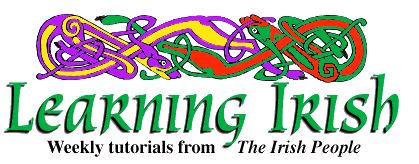
Irish Lesson 30
|
PRONUNCIATION REVIEW The letter "s" recieves its broad sound if an "a, o, u" is the nearest vowel in the word. The sound is very close to the American (s), with lips relaxed and a little trace of hissing. Try: sámh (saw*v), sampla (SAHM-pluh), só (soh), sú (soo), súil (SOO-il), san (suhn), saor (say*r), saoirse (SEER-she), slat (slaht), smál (smaw*l), spúnóg (spun-OHG), srón (srohn), stad (stahd), snas (snahs), stró (stroh), bás (baw*s), bosca (BOHSK-uh). The slender sound of "s" is (sh), as in the English word "shun". It is heard when the nearest vowel is "e,i", unless the combinations "sm", "sp" or "str" occur. With those combinations, "s" always has its broad sound of (s). First try: sean (shan), séid (shay*d), seift (sheft), síl (sheel), simné (SHIM-nay*), seo (shuh), siopa (SHOHP-uh), leis (lesh), cliste (KLISH-te), slí (shlee), sneachta (SHNAHK*-tuh), stiúir (SHTYOO-ir), scríobh (shkreev). Then, for examples of the exceptions to the slender sound, memorize these words: smig (smig), chin; spéir (spay*r), sky; srian (SREE-uhn), bridle; stríoc (streek) stripe. "Is" is an exception and is pronounced (is). GRAMMAR You know the word "ag" (eg), meaning "at", and you have learned how it combines with "me, you", etc., to form "agam, agat" and so on. Other Irish prepositions change similarly. One of these is "le" (le), meaning "with". Here are some examples of "le" with names and nouns that don't have "the" before them: le Seán; le Nóra; le fear, with a man; le bróg, with a shoe. "Le" does not cause aspiration or eclipsis. The name or noun (without "the") is merely added. To say "with me, with you," etc. these are the forms: liom (luhm) with me leat (lat) with you leis (lesh) with him léi (lay*) with her linn (lin) with us libh (liv) with you (pl) leo (loh) with them Pronounce these with a slender "l" (see Lesson 27). Do not make an audible (y) sound; say (luhm), not (lyuhm). If you want to say "with the man", or "with the book", the form is: leis an bhfear (lesh un var), with the man; leis an leabhar (lesh un LOU-wuhr) with the book. Eclipsis often occurs, and here are examples of it: leis an mbád (lesh un maw*d) with the boat leis an gcarr (lesh un gahr) with the car leis an ndoras (lesh un NUH-ruhs) with the door leis an bhfeirm (lesh un VER-im) with the farm leis an ngairdín (lesh uhng ahr-DEEN) with the garden leis an bpáipéar (lesh un baw*-PAY*R) with the paper leis an dteanga (lesh un DYANG-uh) with the tongue (or language) "D" and "t" are not eclipsed by "leis an" as often as are the other letters above. "Leis an doras" and "leis an teanga" are common. VOCABULARY "Le" serves in many expressions in Irish. It commonly follows some important verbs, sometimes being used where English would use "to". Learn these expressions and verbs: Dúirt sé liom é (DOO-irt shay* luhm ay*), he said it to me. Abair leis dul abhaile (AH-bir lesh duhl uh-VWAHL-e), tell him to go home. Imigh leat (IM-ee lat), be off with you. Dimigh sé leis (DIM-ee shay* lesh), he departed (went off with himself). Tig liom rince (tig luhm RINK-e), I can dance. Ní thig leat léamh (nee hig lat LAY*-uhv), you can't read. An dtig leat é a dhéanamh? (un dig lat ay* uh YAY*N-uhv), can you do it? Éist liom (ay*sht luhm), listen to me. D'éist sí liom (day*sht shee luhm), she listened to me. Fan liom (fahn luhm), wait for me. Dfhan sé liom (dahn shay* luhm), he waited for me. Níor fhan sé leo (NEE-uhr ahn shay* loh), he didn't wait for them. DRILL With each of the forms in the Vocabulary (except "imigh" and "d'imigh"), substitute: le Seán; leis an bhfear; leis an gcailín. CONVERSATION Now that our pronunciation review is largly complete, we will emphasize conversation again. This week, we stress the past tense and "le". Next week, we will begin conversation drills in which you will take part by forming you own replies and answers. Dónall (DOHN-uhl): Cé bhuail an teach sin? Tá balla leagtha (BAHL-uh LAG-huh). Who hit that house? There's a wall knocked down. Pól (pohl): Ó, bhí timpist ann aréir (uh-RAY*R). Oh, there was an accident there last night. Chuaigh (K*OO-ig) tiománaí (ti-MAW*-nee) trí solas dearg (DYAR-ruhg) agus carr eile ag teacht go tapaidh (TAHP-ee). Chas an chéad (HYAY*-uhd) charr, ach ní raibh an t-ádh (taw*) air. A driver went through a red light while another car was coming fast. The first car turned, but luck wasn't with him. Tháinig sé suas ar an gcosán (guh-SAW*N) agus direach isteach sa bhalla. D'éistíomar leis na tiománaithe ag caint le chéile. Drochchaint (druhk*-K*EYENT) ar fad. He came up on the sidewalk and right into the wall. We listened to the drivers talking to each other. Terrible language. Dónall: Cad a tharla (HAHR-luh) ansin? What happened then? Pól: Tháinig cara leis an tiománaí agus tharraing sé an carr briste chuig garáiste (k*ig guh-RAW*SH-te). A friend of the driver came and towed the damaged car to the garage. Dónall: Nach mór an trua é. What a shame.
(c) 1997 The Irish People. May be reprinted with credit. |